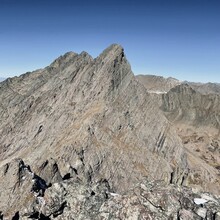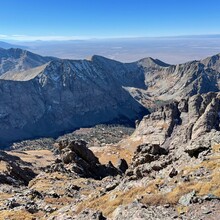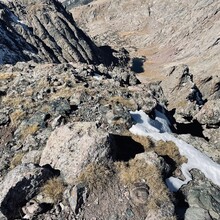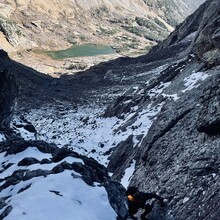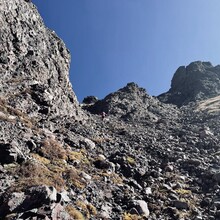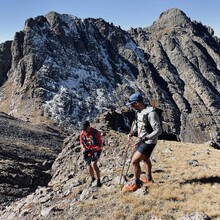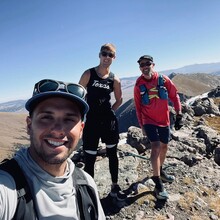13,575 – Broken Hand Peak FKT Trip Report
On 10/15/22 a group including myself, Evan Paul & Patrick McClellan set out to set an
established route & unsupported-group Fastest Known Time of Broken Hand Peak, the
13,575 ft neighbor directly to the Southeast of the Crestone Needle. There were several
motivations for this attempt, the most important being that this peak provides a good mix
of technical uphill running, combined with the necessity of technical scrambling on Class
2+ to Class 3 terrain, and that a solid defined route up and down the peak could provide
for a classic route in the future that other athletes could enjoy and put down strong
times on. The views of the Crestone’s and Sangre De Cristo range are unparalleled.
We set out early on 10/15/2022 – at about 7:15 in the morning. We met at the 2-wheel
drive parking lot down South Colony Lakes Road at 6:40 and took the 4-wheel drive
road up about 2.5-2.7 miles to the 4-wheel drive trailhead. Which was the defined start
point of our route. The starting temps were a little brisk (in the low 30’s) however the
weather window we were chasing was near perfect for mid-October, with zero projected
precipitation, clear blue skies and temperatures projected for the mid-40’s as high as
14K ft.
From the 4-wheel drive parking lot start point the next three miles are rather uneventful.
Starting at an elevation of about 10K ft and running through aspen groves on the old
South Colony Lakes Road until you pop out at a junction just below the South Colony
Lakes cirque. At this junction you can either go left or right – left toward Broken Hand
Pass and our objective or right toward South Colony Lakes and the standard route of
Humbolt Peak. We went left, and over the next half mile the basin opens up to stunning
views of the Crestone Needle, Humbolt Peak and our objective, Broken Hand Peak.
The peak itself is rather obviously spotted from this direction as it does sort-of resemble
a hand at various angles. The other tell-tale way of knowing the objective was that the
peak sits directly to the left of broken hand pass.
Despite the near perfect weather window, we did encounter some left-over snow going
up Broken Hand Pass from a snowfall the week to a few days’ prior. The pass sits in a
corner, keeping sunlight from peeking in most of the day. The way up the pass was
rather easy, 99% class 2, with a move or two that could be argued to be class 2+ or
class 3. We did however pose the question on how sketchy the route would be coming
down the pass, the snow was extremely slick and didn’t seem to keep stability with
micro spikes. That said, we navigated the pass with ease, and dropped off the backside
into the basin of about 200 feet. One the way down we could clearly see the back side
of Broken Hand Peak and the objective route in which we did our best to avoid as many
class 3 moves as possible. The route is rather blank and from the bottom of Broken
Hand Pass to the Broken Hand Peak summit is about 1.2+ miles with about 1500 ft of
climbing. We planned for the experience to be harder with the known blank sections,
however we were rather fast in our summit. We navigated the sections trying to stick to
the class 2 grassy and hard rock lines, avoiding the loose skree with only a few portions
of mixed class 2+ \ class 3.
We hit the summit, hung out for maybe 5 minutes for photos and then started our
descent knowing the crux of the route was still ahead. We were careful on the
downclimb of Broken Hand Peak, not taking the exact line we took up, but descending
via the saddle that bridges Broken Hand Peak with Crestolita Peak. This was less
direct, however had slightly less-steep grades but had mixed slippery grass. As runners
we felt that the approach and descent routes would provide for the most efficient, safe,
and logical routes. Each member of our group slipped at least once on the grassy
sections; however, it would have arguably been worse on the skree fields. It took maybe
20+ minutes to re-connect with the Broken Hand Pass trail.
The crux of the trip came on down climbing Broken Hand Pass. Normally this route sits
at about Class 2+. And in solid conditions a strong technical runner could fly down this
route. However, with extremely slick snow and poor spike traction (some of us didn’t
bring spikes) it became an entirely different experience. One mistake could have
consequences, and we found ourselves slipping and sliding often. The first 300 ft of
descent is the crux, where you’re looking down into the pass knowing that if you
slip there could be significant danger. We took our time and descended successfully. I
strongly recommend possibly bringing a set of ice spikes or an ice axe in conditions like
this, and if trying to lay down a speedy time perhaps doing it without snow. We
descended off the pass back onto South Colony Lakes Trail \ Road and ran the
remaining few unexciting miles back down to the 4-wheel drive parking lot.
Overall, this is an exciting route and an awesome experience. I highly recommend this
route to others as I think the mix of technicality on the climbs with run-ability on the
approach and descent makes for something a little easier than the Needle or Crestone
Peak, but significantly more challenging than say, Humbolt Peak.
JL’s Gear Selection
Black Diamond Equipment
- Distance 8 Pack
- Distance Spikes
- Rhythm T-Shirt
- Sprint Shorts
- Alpine Glow Hoodie
- Ice Axe
Poles
- LEKI Ultra FX-1 Super Light
Shoes
- Hoka Tecton X – Don’t recommend for outings like this
Editorial Blog
Lessons Learned in the Backcountry, a Story of New Routes, Big Adventures and Getting Humbled in the Sangre De Cristo Wilderness
It’s not every day that you experience a little more of your humanity; that primitive feeling of being so completely dialed into exactly what you’re experiencing in that moment, place, and time in the universe and to walk that fine line between what’s within your abilities and what lies just outside.
While many may view running in the mountains as a purely athletic endeavor, it can actually be so much more. In the last few years, I’ve sought to express myself by unearthing more of my creative potential through hard mountain objectives, namely the creation of new routes and peak linkups. With this intention in mind, I look to find more vertical, arduous routes that could be logical yet outside the box choices for out-and-back or linkups of various Colorado peaks. Throughout late 2021 and 2022, my muse has been the Sangre De Cristo range. While some routes I choose to keep to myself, others have garnered enough of my stoke that I felt they were worthy of a Fastest Known Time (FKT) route designation. My experience on Broken Hand Peak, a 13,000 ft peak in the Sangre was one of these choices.
The Sangre De Cristo range is a lesser traveled grouping of peaks about two hours from my home base in Colorado Springs. The range runs southeast for 75 miles through south-central Colorado into Northern New Mexico. You may be familiar with a few of its daunting 14,000-ft peaks that include Blanca, Ellingwood, Little Bear, Kit Carson, and the iconic Crestone Needle, amongst others. The range is intimidating at the very least, sporting an additional seventy-six 13,000 ft peaks, some of which are unnamed or have ambiguous established routes.
Many inspiring routes have been set in the Sangre peaks in recent years. The most notable, and awe inspiring to me, is the Sangre De Cristo Traverse, a 103-mile route with approximately 53,000 ft of vertical gain that is mostly off trail, traversing a total 77 peaks, 5 of which are14ers and 33 13ers. Completing this route in an unsupported fashion is a mind-blowing accomplishment, one that Hannah Green set for the women’s FKT in 2022 and Ty Smith time in 2021, besting Justin Simoni’s unsupported time. Efforts like this inspired my pursuit of establishing an FKT route and setting the unsupported standard on Broken Hand Peak, the 13,575-ft little brother of the Crestone Needle.
On October 15th, 2022, myself and two friends – Patrick McClellan and Evan Paul- set out to the Sangre De Cristo range. We aimed to take advantage of the perfect weather window mid-October had given us. Our goal was to snag the summit and, in the process, establish the most logical out and back route on Broken Hand Peak from the South Colony Lakes Trailhead, which lies on the eastern side of the Sangre De Cristo range, just outside of Westcliffe, Co.
There were several motivations to establish this route, as it offers the mountain athlete a little mix of everything. The course from South Colony Lakes over Broken Hand Pass and onto Broken Hand Peak provides a good mix of semi-technical uphill running, leading to a scramble on Class 2+ to Class 3 terrain, where good route-finding skills is pertinent. A solid defined route up and down the peak provides a great option in the future for athletes to establish fast times on a technical peak. This would also provide athletes with a GPX file via the FKT website so that they may safely tag both Broken Hand Peak and the Crestone Needle without having route finding issues.
The views of the Crestones and Sangre De Cristo range are unparalleled. Looking at the peak from the South Colony Lakes Cirque (looking W/SW) the peak sits directly east of the Needle, with Broken Hand Pass separating the two. From this direction the route is class 4+, with sheer walls of mixed purple and red Crestone Conglomerate and shale. The southwestern facing route, however, is an approachable Class 2+ / 3 if accessed from the backside of Broken Hand Pass.
It’s easy to assume that establishing the most approachable route might be easy, however our experience was anything from it. There was very little beta available online for this peak, and I almost liked it better that way; I honestly couldn’t think of the last time I had little clue as to what I was getting myself into. While we were prepared in a myriad of other ways, I was excited for the unknown. This sense of exploration and adventure validated the little kid in me that used to watch Indiana Jones films back-to-back.
Our effort started out as any other, with a sunrise approach from the 4-wheel drive trailhead up the semi-technical South Colony Road into the South Colony Lakes Basin. This cirque provides some of the most stunning views in Colorado, being surrounded by the Crestone Needle and Humbolt Peak. From here we navigated Broken Hand Pass. Several days earlier the basin had some snowfall, however most of the snow had melted apart from the pass. On our ascent we questioned how the snow would impact our descent as we had brought limited gear to safely navigate this potential issue. A poor calculation that would later become problematic.
Once we dropped off Broken Hand Pass and descended into the neighboring basin, we got our first look at the south side of the peak and started to figure out our route. At this point we leveraged a combination of a GPX I had put together on Strava using 3D maps, GAIA Maps, and our basic route-finding skills. From here, the route is entirely blank, and we began to navigate a 1500-ft, one mile section of mixed Class 2+\3 climbing switching to endless skree fields and intermittent grass that was extremely slippery. Surprisingly, we navigated this section extremely well with a couple lucky guesses to successfully find an approachable way to the summit with the least amount of Class-3 moves.
The real crux of the trip came on our descent. While we experienced a relatively smooth and easy descent of Broken Hand Peak, and ascent of the back side of Broken Hand Pass, the real issue posed itself while climbing down Broken Hand Pass and back into the South Colony Lakes Basin. Normally, this route sits at about Class 2+ with a section or two you could argue as a Class-3 move, but with the extremely slick snow and poor traction, it certainly changed the dynamics of the route. One mistake could have had some unfortunate consequences. I can recall speaking with others who were far more experienced and were in the same basin on that day to climb the Crestone Needle, and they were un-nerved by the sketchiness of their experience descending Broken Hand Pass in these conditions.
As we began our decent into the pass, there was some slipping and sliding on the slick snow. Evan, who had the most experience amongst us, went first. He was careful to use his heels to create small holds in the snow that we could grip to. As I was descending, I zeroed into the moment, free of drifting thoughts, and my goal became to find solid holds to anchor my feet and hands as we downclimbed.
The first 200-ft of descent is the crux, which appears steeper than it actually is, and the snow conditions had become the biggest issue. Others have fallen to their deaths or have been seriously injured in this same area, and the easiest way to freak yourself out is to have intrusive thoughts, such that if you slip, there’s nothing to catch you. I did my best to anchor myself with one of the poles I broke on the ascent, and- I’m not ashamed to say it- even butt-scooted a small section that warranted that move with the snow.
About halfway down the crux, there is an exposed section with no holds and slick snow. Having been in similar situations to this, this section played mental gymnastics with my psyche. While navigating down this blank section, I stopped and froze. For the first time on an adventure, I was a little surprised to feel panic. My mind zoned away from the present and into thoughts of the potential consequences. I thought about my loved ones. I thought about the recent and saddening loss of many runners and climbers pushing their limits too far in the back country. I thought about what would happen if I slipped. I thought about my limits, and if I pushed a little too hard this time. As swiftly as I began to feel panic, I pulled myself back into the present, comprehended that trepidation was not the best option and realized I was not alone and that I needed to figure it out. When I came back into the present, we were off the crux and into the gully, and that moment had passed me by. When we got off the pass, we descended the 6 miles back to the 4-wheel drive lot, with nothing but a wild experience to fill our conversation the rest of the way.
As we approached the car, the anxiety I felt on the pass overshadowed the success of the day and I remember leaving with mixed feelings. As a driven mountain runner, mixed feelings such as these tend to manifest into reflection on improvement, and within the following week, I found myself in the climbing gym learning an entirely new sport and working on skills that I could apply to next season in the big mountains.
About a week after our Sangre De Cristo adventure, the Colorado Sun published an article that was shared throughout our community. This article echoed the sentiment I feel like I’ve heard community pillar, Buzz Burrell, explicitly say on the Fastest Known Podcast more than once: runners have the fitness to do incredible things in the backcountry, but we also need to possess the skills to navigate the technical aspects to get ourselves out of tough situations that come up. The article drew on the parallels between trail and mountain running of today vs backcountry skiing from decades past. As the sport grows and athletes improve, the gear gets lighter. I get it, I tend to have a similar mindset, in that the lighter I can go in the mountains, the faster I can move. When it comes to fast objectives, I tend to stray from hydration vests to just a belt and a flask. It wasn’t until I had a long day out in the Collegiates last summer with a friend and SAR member that I became enlightened about the potential dangers and risks that even light-hearted intentions on big mountains pose. We discussed some rescues he had participated in which led to the topic of body retrieval in the mountains, and it became apparent that an extra layer, In-Reach, and filter flask might not be a bad decision in the high country.
This past summer, the reality of unpreparedness was quite crushing for our community, as we lost multiple, beloved community members while they were out in the mountains doing what they loved. The thought of these accidents became ever present as loved ones reached out with persuasion, asking me to be extremely careful, or to avoid technical terrain altogether. This left me with mixed emotions, being torn between wanting to have fun in the mountains, but also the feeling of responsibility to be more careful. My experience in the Sangre, although relatively mild, really got me thinking- have I just been getting lucky?
In October of 2021, I set the FKT on Marble Mountain, a significantly less technical 13,000 ft peak in the Sangre De Cristo Range. However, I did it in shorts with one-layer, limited gear, and in an ice storm with 20-ft of visibility. The weather was so poor that my watch wouldn’t connect to the GPS for more than 5 minutes at a time. In that moment, I was driven to push hard and achieve my goal without comprehending the potential consequences. People reading this might have their judgments, however I would imagine many of us have had that feeling of dire pursuit before. It wasn’t until my experience on Broken Hand that I looked back on last year’s Marble Mountain outing, putting ego aside and realize there may have been a lot of luck involved there.
I know my personality conflicts strongly with the persuasions of responsibility I received from others, as I had once adopted the belief that I have a higher chance of dying in a car accident driving to my boring job in finance than I do in the mountains. I, like many others, choose to do hard things not for the thrill of running or achieving the goal, but because these hard things help me push to further understand my boundaries, provide inner-equanimity, and bring me closer to understanding who I am. If I learned anything from my experiences this summer and fall, namely my experience on Broken Hand Pass, it is that the mountains have a silent way of humbling you, and there is no room for ego. We need to be self-aware and understanding of the factors out of our control, such as shifts in weather, and accepting of the risk while harboring responsibility.


